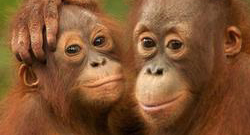
Greenpeace protest to stop whaling in Russian waters
- 1848: Whaling enters the industrial age with the invention of the exploding harpoon.
- 1905: The introduction of factory ships leads to massive growth in the whaling industry. These floating processing plants are able to decimate whale populations at the rate of up to 40,000 a year.
- 1930: 80% of the the great whale species are feared to be on the verge of extinction.
- 1946: The International Whaling Commission (IWC) is created by the world's 14 whaling nations to manage whale stocks.
- 1972: The number of blue whales, the largest creatures on the planet, sinks to less than 6,000.
- 1975: Greenpeace launches its anti-whaling campaign, confronting whaling fleets on the high seas. Faced with the grisly realities of commercial whaling, public opinion begins to turn against the whalers.
- 1979: The anti-whaling lobby gains ground at the IWC, which establishes the Indian Ocean Whale Sanctuary as a practical conservation measure.
- 1982: The IWC is successfully lobbied to establish a moratorium on commercial whaling, taking effect from 1986.
- 1983: The Convention on International Trade in Endangered Species of Wild Fauna and Flora (CITES) bans international commercial trade in whale meat and confers protected status on the world's great whales.
- 1987: Japan begins its so-called "scientific" whaling programme.
- 1990: Seven out of the nine remaining whaling nations agree to abandon the industry.
- 1993: Norway lodges an objection to the moratorium and resumes commercial whaling, killing 500 minke whales per year.
- 1994: Southern Ocean Whale Sanctuary created to protect the great whales in their breeding grounds.
- 1994: Survey results show that over 5 million people go whale watching in 65 countries. This eco-tourism is actually more profitable than commercial whaling.
- 1998: Brazil proposes a Southern Atlantic Sanctuary. Australia and New Zealand propose Southern Pacific Sanctuary.
- 1999: Japan's steps up its vote buying strategy at the IWC, and establishes a "blocking minority" to prevent the creation of a South Pacific Whale Sanctuary.
- 2000: Japan and Norway attempt to remove the protected status of whales at the CITES meeting in Nairobi in April 2000. If successful this would pave the way for a return to international trade in whale products.They fail by a narrow margin.
- 1999/2000: Greenpeace vessel MV Arctic Sunrise confronts Japanese whaling fleet in the Southern Ocean Sanctuary. 1999 The MV Sirius carries out similar work off the Norwegian coast.
- 2001: Whale watching is now a thriving industry in 87 countries, generating an income of US$1 billion worldwide each year.
- 2001: Japan admits to using overseas aid to buy support from developing nations for a return to commercial whaling.
- 2001: Greenpeace confronts the Japanese fleet and films a whale being harpooned in the Southern Oceans whale sanctuary.
- 2002: Japan uses votes bought from 14 other nations to block whale sanctuaries and deny indigenous peoples subsistence quotas - at the IWC meeting in Shimonoseki, Japan.
- 2002: Mexico creates the world's largest national whale sanctuary - in all of its EEZ (Exclusive Economic Zone) in the Pacific, Atlantic and Carribean Sea - to protect 21 species of cetaceans.
- 2002: Iceland is voted in as a full member of the IWC - despite refusing to follow the rules and despite their intention to resume whaling in 2006.

